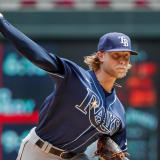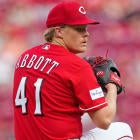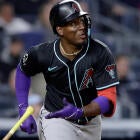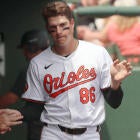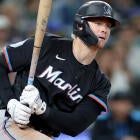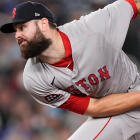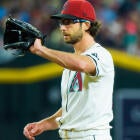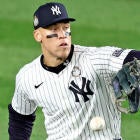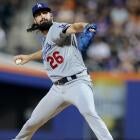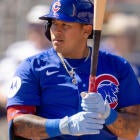
When it comes to draft season, being skeptical about prospects is probably the best approach. Spending a top-150 pick on a totally unproven player is an easy way to get your heart broken, a lesson most drafters learned this spring.
But once the season starts, all bets are off. Draft picks are incredibly valuable, and using them on veterans with more proven track records is probably the best approach because you're less likely to run into a totally wasted pick. A big loss, something that really costs you, is to be avoided.
But big losses aren't really an issue once the season starts, at least when it comes to the waiver wire. Oh sure, you could spend too much of your FAB budget on someone who ends up being unworthy of it, but even that isn't that big of a deal, for the simple reason that most waiver-wire pickups throughout the season aren't going to make a difference for your team. Even overextending yourself on a big bid for a top prospect only has so much downside, because the potential for a big win definitely outweighs what you're typically risking.
And that's precisely because most of the alternatives on waivers throughout the offseason aren't likely to make any kind of impact. That's less true in the first couple of weeks of the season, when young players unexpectedly pop or veterans unexpectedly show off some new skill that could drastically change their outlook. But once those early-season breakouts are accounted for, you're typically talking about veterans on hot streaks they are unlikely to sustain or small-sample size heroes without the skills to back them up, and in that context, getting excited about top prospect call-ups makes a lot of sense.
And we've had a bunch of them get the call recently. The most notable probably being Chandler Simpson, the Ray's lightning-quick center fielder who is trying to bring back the days of Juan Pierre and Michael Bourn to the majors. But he certainly wasn't the only prospect of note to get the call over the past week – Agustin Ramirez will join the Marlins in the next few days, and Luke Keaschall, Edgar Quero, Caleb Durbin and more have already made their debuts. And Nick Kurtz is looming as arguably the top prospect stash, with his debut feeling inevitable with each homer he crushes.
So, we will focus on top prospects in this week's look at the waiver wire, and you shouldn't be afraid to be aggressive with them. They aren't all worth 20% bids in FAB – though Simpson might be – and the likeliest outcome with each is probably that they aren't a difference maker right away. But they might be, and if you hit on one of those on the wire, it can give your team a big lift. That's what we're always on the lookout for.
Here's who we're targeting this week:
Week 5 Waiver Targets
Catchers
Sean Murphy, Braves (64%) – I don't know if Murphy can sustain his hot start and get back to his pre-2024 production levels. There's still been an awful lot of swing-and-miss in his game in the early going, after all. But one thing I do know is there aren't many catchers who have shown must-start upside for more than a few weeks at a time, and Murphy is definitely one of them. I'd rather start Murphy than Austin Wells or Keibert Ruiz, two who are more widely rostered than him.
Agustin Ramirez, Marlins (9%) – The Marlins are calling Ramirez up, and that's definitely the more interesting of the two top catching prospects getting called up this week. Ramirez was hitting .258/.320/.500 with three homers and five steals to open the season at Triple-A, carrying over his breakout from last season. He's now hitting .248/.340/.430 with 12 homers and 14 steals in 86 career games at Triple-A, and it's pretty easy to see how this profile could be very impactful for Fantasy; even if he hits for a low batting average, that kind of power and speed is rare at the position. I think it's pretty unlikely that Ramirez will actually be a 20-20 guy in the majors, but a 20-homer ceiling with double-digit steals would be plenty valuable for any category league. I think he's pretty close to a must-add in any two-catcher league where you have a boring No. 2 option.
Deep-league target: Edgar Quero, White Sox (10%) – Quero has put up better numbers than his underlying numbers would make you think throughout much of his minor-league career, including at Triple-A, where he has been an above-average hitter in both stints last season and this. He might get exposed in the majors, but he also might just be a "better than the sum of his parts" type player. At catcher, I'm willing to take a flier on that chance.
First Base
Jonathan Aranda, Rays (70%) – The key thing keeping Aranda's roster rate from climbing much higher than this is that the Rays haven't shown much willingness in starting him against lefties, something he has done just once in his first games. With the team hitting just .221/.314/.337 against southpaws, it's probably worth seeing if he can carry over his success to same-handed pitching. Either way, Aranda looks likely to face just once lefty starter this week, so we'll just roll him out there in all leagues until he cools down or has a schedule with too many lefties.
Deep-league target: Ty France, Twins (19%) – France has had flashes this season, though he enters Week 4 in a bit of a cold spell, going 1 for 20 over the past six games. But he's playing regularly, has very little risk of losing playing time, and has a .273 xBA and .352 expected wOBA for the season, suggesting better days are ahead.
Second base
Luke Keaschall, Twins (22%) – Keaschall's promotion was largely the result of a bunch of injuries to the Twins starting lineup, which probably means he doesn't have a particularly long leash here. He's going to have to hit to keep his spot in the lineup, and that's what he's done in the early going, going 4 for 12 with a couple of troubles, a steal, and only two walks in his first three games. Keaschall is talented enough to play his way into a consistent role on a Twins team that wants to keep pushing for a playoff spot, so while there's plenty of risk that he gets sent back down relatively quickly, he could change that for himself if he keeps hitting.
Caleb Durbin, Brewers (26%) – The same can be said for Durbin, who has started the first three games of his MLB career. The Brewers have plenty of players with similar skill sets and pedigree as Durbin, but they liked him enough to make him the centerpiece of the Devin Williams trade this offseason, and it looks like they're giving him a real chance to play regularly here. It's an interesting skill set, and while I think Durbin got a bit overhyped by the Fantasy community this offseason, his blend of contact skills and speed could help him matter on a Brewers team that loves to run.
Third base
Dylan Moore, Mariners (53%) – I don't have much trouble buying Moore as a useful Fantasy option – his 32 steals last season made him pretty useful in Roto leagues, after all. But I certainly don't buy him as the well-above-average hitter he's been so far this season. But he hit another homer Sunday, his fifth of the season, and he's playing an awful lot for the Mariners right now. Moore will probably turn back into a pumpkin before long, but he's hot right now, has positional versatility, and multiple ways to help your team. He should probably at least be rostered in all categories leagues until he slows down.
Deep-league target: Noelvi Marte, Reds (13%) – We probably shouldn't take too much out of Marte's performance Sunday against the Orioles, since two of his five hits did come against position players. On the other hand … three of those hits didn't come against position players! Baby steps! He had a couple of singles and a double against real pitchers, and it was the second game in a row Marte has started for a beat up Reds team. Sunday's game probably earned him another opportunity, so let's see if the former top prospect can take advantage of it. Remember, he hit .316/.366/.456 and looked like a future star back in 2023, and he's still just 23 years old.
Shortstop
Gabriel Arias, Guardians (33%) – If you need a shortstop, this isn't a great time for it. Arias had a solid spring and has carried it over to the start of the season, hitting .277/.333/.508 through the first 20 games. I don't really buy it, but the underlying data does suggest it isn't a total fluke, and Arias has hit well enough in Triple-A that you could see him being a pretty useful hitter in deeper leagues.
Deep-league targets: Thomas Saggese, Cardinals (9%) – Similarly, Saggese has a pretty good minor-league track record, hitting .285/.354/.489 across his career, with decent speed and power. He's hitting very well early on this season, but I'm just not sure how long he's going to be in the lineup with Masyn Winn homering twice on his rehab outing this weekend.
Outfield
Chandler Simpson, Rays (42%) – Among players who had at least 300 PA, Simpson led the Southern League last season with a .351 batting average and 73 stolen bases, and his 7.5% strikeout rate was also the lowest in the league. He's a player of extremes, sporting the fourth-lowest ISO at the level, and it's a profile that is tough to make work against MLB pitchers – if you can't prove you can make them pay for it, MLB pitchers will be happy to fill up the zone against you, dragging walk rates down and strikeout rates up. But if Simpson can be something like "Luis Arraez, but with Elly De La Cruz's baserunning skills," well, it's easy to see how that could be a very, very valuable Fantasy option. At the very least, Simpson needs to be universally rostered in all category leagues, because he could lead the majors in steals even with a late start to the season.
Austin Hays, Reds (35%) – Well, the first six games of Hays' season couldn't have gone any better. After going 4 for 7 with four runs on Sunday, he's now hitting .429 with three homers, seven runs, and eight RBI. Hays probably isn't suddenly making the leap to superstardom all of a sudden, but he was a solidly above-average hitter from 2021 through 2023, but was held back by one of the worst parks for right-handed power hitters in Baltimore. Now he's in arguably the best park for power, and a career-best season could be well within reach.
Kameron Misner, Rays (31%) – Misner just continues to hit, and he's up to .360/.404/.660 through his first 57 plate appearances. There's always playing time risk in Tampa, and Misner isn't quite playing everyday yet, though he's not far off. And while this level of production isn't sustainable, he was solidly above-average in 2023 and 2024 at Triple-A while bringing power and speed to the table. In deeper category leagues, he might continue to matter.
Alex Verdugo, Braves (5%) – Even at the best of times, Verdugo is rarely much better than "decent" for Fantasy, so this isn't a high-upside target. But the Braves suddenly really need him, and it wouldn't surprise me if he ended up being good enough to remain a staple for much of the season. You're probably looking at mid-teens homers and a good batting average in the best-case scenario, but if this lineup ever lives up to its potential, that could be enough to make him matter.
Tirso Ornelas, Padres (4%) – It was a mild surprise when the Padres sent Ornelas down after a solid spring, but with Jason Heyward on the IL with a knee issue, Ornelas got to make his MLB debut this weekend. He's a pretty low-end prospect, but he has hit well enough in Triple-A to think he might be a useful option for the Padres if he can hang on to a role.
Starting pitcher
Tyler Mahle, Rangers (71%) – Skepticism is the right response to Mahle's recent run of success, which now includes seven shutout innings against the Dodgers Sunday. In that one, he limited the Dodgers to just two hits while walking three and striking out four, which should make you even more skeptical – this was not a dominant performance by any means. On the whole, Mahle has a 24.8% strikeout rate and 11.8% walk rate, which again, doesn't exactly scream "dominant." But he is doing a good job of limiting hard contact, and has flashed strikeout upside when he struck out nine against the Angels earlier this week. Add him while he is hot, but don't expect Mahle to be a difference maker moving forward.
Landen Roupp, Giants (43%) – One guy who is flashing potentially difference making upside is Roupp, who now has at least eight strikeouts in three of his first four starts after he set down nine Angels in seven innings Saturday. He's just going all-in with his curveball, throwing it as his primary pitch and racking up massive swinging strike numbers with it – after Saturday's start, his curveball has a massive 57% whiff rate. And his changeup looks pretty solid too, while his fastball has been good enough – very few whiffs, but he's doing a good job of limiting hard contact with it, at least. The control has occasionally been iffy, but on the whole, Roupp has looked very solid, with a 4.09 ERA backed up by an even better 2.91 mark. There's a chance Roupp ends up being a must-roster pitcher this season.
Hayden Wesneski, Astros (60%) – Wesneski probably won't be much more than the high-3.00s ERA guy he has been so far, but with a good supporting cast around him and a deep arsenal with a few swing-and-miss pitches to lean on, there could be enough else going on here to overcome a high-ish ERA. I don't think Wesneski needs to be 100% rostered, but the schedule looks favorable enough moving forward – @KC could be tough despite their overall struggles, but then vs. DET and @MIL aren't enough to scare me off.
Andrew Abbott, Reds (39%) – I've never been much of a believer in Abbott, but I will admit, it's easier to buy in when he's actually getting strikeouts, something he didn't do much of last season. However, he got 11 of them Friday against the Orioles, and he's off to a very good start while prioritizing his changeup and curveball ahead of his sweeper. Abbott's velocity is down nearly 2 mph from last season, which is pretty worrisome after he dealt with shoulder injuries last season, and my guess is this will fall apart pretty soon for one reason or another. But I've been wrong about Abbott before. That being said: We're probably avoiding him in Coors Field.
Logan Henderson, SP, Brewers (13%) – I was excited to see what Henderson could do, but I'll admit, I wasn't this excited. In his MLB debut Sunday against the A's, he made it through six innings with just one run allowed, while striking out nine, walking one, and allowed just three hits. He came as advertised mostly, with a fastball with mediocre velocity but excellent shape and command that allows it to play up, plus a terrific changeup that generated seven whiffs on 19 swings in this one. There isn't much else there – a cutter he threw four times and a slider he threw just twice, both of which got hit hard when he threw them – and the lack of velocity combined with a limited arsenal makes Henderson tough to buy into. On the other hand, a nine-strikeout kind of speaks for itself. I'm not willing to say he's an ace already, but in a world where Easton Lucas was added in a bunch of places last week, I'll happily take a flier on Henderson to see if there was something there.
Eduardo Rodriguez, Diamondbacks (62%) – There's no big change to point to with Rodriguez. His velocity is right where it was last season, and his pitch mix is nearly identical as well. He's just a solid pitcher who is executing really well right now, something he just didn't do at all last season. But he did in 2023, when he had a 3.30 ERA, 13 wins, and a 1.15 WHIP. His 30% strikeout rate probably isn't sustainable – it's inflated by a nine-strikeout outing against the Marlins and a 12-strikeout showing against the Nationals – but Rodriguez is a solid pitcher backed up by a great supporting cast, and I have no problem trusting him against the Rays this week. And next week might be a two-start one (albeit with tough matchups against the Mets and Phillies to worry about), so he could be a lineup fixture for a while.
Matthew Liberatore, Cardinals (29%) – I don't really buy it, but Liberatore is finding success with a new approach of late. Liberatore has led with his slider in consecutive starts while also sitting around 95 mph with his fastballs, up 1.5 mph from where he was in his first couple of outings. That slider has always been Liberatore's best pitch, and maybe featuring it this much can help the rest of the arsenal play up. I'm pretty skeptical, but his 3.07 xERA suggests his success so far isn't a total fluke so far.
Relief pitcher
Tommy Kahnle, Tigers (39%) – This one really doesn't look like any kind of committee – the three saves that didn't go to Kahnle were: Two three-inning outings by Brant Hurter and then a Will Vest save Saturday after Kahnle had pitched the previous two days. Kahnle has a 2.34 ERA, 1.02 WHIP and 27% strikeout rate since the start of the 2022 season and might just be a must-roster closer now.
David Bednar, Pirates (27%) – There's been surprisingly little movement around closers in the past couple of weeks, so I'll just highlight Bednar here, who has looked solid since going down to Triple-A, striking out seven and walking none in five innings of work. The rest of the Pirates bullpen remains underwhelming enough that I think the eventual plan is to get Bednar back into the ninth. It's mostly just a question of how long it takes to get there.
![[object Object] Logo](https://sportshub.cbsistatic.com/i/2020/04/22/e9ceb731-8b3f-4c60-98fe-090ab66a2997/screen-shot-2020-04-22-at-11-04-56-am.png)






